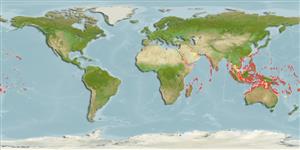Common names from other countries
Teleostei (teleosts) >
Anguilliformes (Eels and morays) >
Muraenidae (Moray eels) > Muraeninae
Etymology: Gymnothorax: Greek, gymnos = naked + Greek, thorax, -akos = breast (Ref. 45335).
More on author: Smith.
Environment: milieu / climate zone / depth range / distribution range
Ecology
Marine; reef-associated; depth range 0 - 43 m (Ref. 37816). Tropical; 30°N - 28°S, 34°E - 149°W
Indo-Pacific: East Africa to the Society Islands, north to the Amami Islands in Japan and the Marshall and Hawaiian islands, south to the southern Great Barrier Reef.
Size / Weight / Age
Maturity: Lm ? range ? - ? cm
Max length : 39.0 cm TL male/unsexed; (Ref. 1602)
Occurs on reef flats as well as lagoon and seaward reefs to a depth of at least 43 m. Benthic to 40 m (Ref. 58302, 75154). Cryptic (Ref 90102).Minimum depth reported taken from Ref. 86942.
Life cycle and mating behavior
Maturities | Reproduction | Spawnings | Egg(s) | Fecundities | Larvae
Randall, J.E. and D. Golani, 1995. Review of the moray eels (Anguilliformes: Muraenidae) of the Red Sea. Bull. Mar. Sci. 56(3):849-880. (Ref. 10713)
IUCN Red List Status (Ref. 130435)
CITES (Ref. 128078)
Not Evaluated
Threat to humans
Harmless
Human uses
Fisheries: minor commercial
Tools
Special reports
Download XML
Internet sources
Estimates based on models
Phylogenetic diversity index (Ref.
82804): PD
50 = 0.5000 [Uniqueness, from 0.5 = low to 2.0 = high].
Bayesian length-weight: a=0.00047 (0.00025 - 0.00089), b=3.28 (3.13 - 3.43), in cm Total Length, based on LWR estimates for this Genus-body shape (Ref.
93245).
Trophic level (Ref.
69278): 3.8 ±0.6 se; based on size and trophs of closest relatives
Resilience (Ref.
120179): Medium, minimum population doubling time 1.4 - 4.4 years (Preliminary K or Fecundity.).
Fishing Vulnerability (Ref.
59153): Low to moderate vulnerability (29 of 100).
